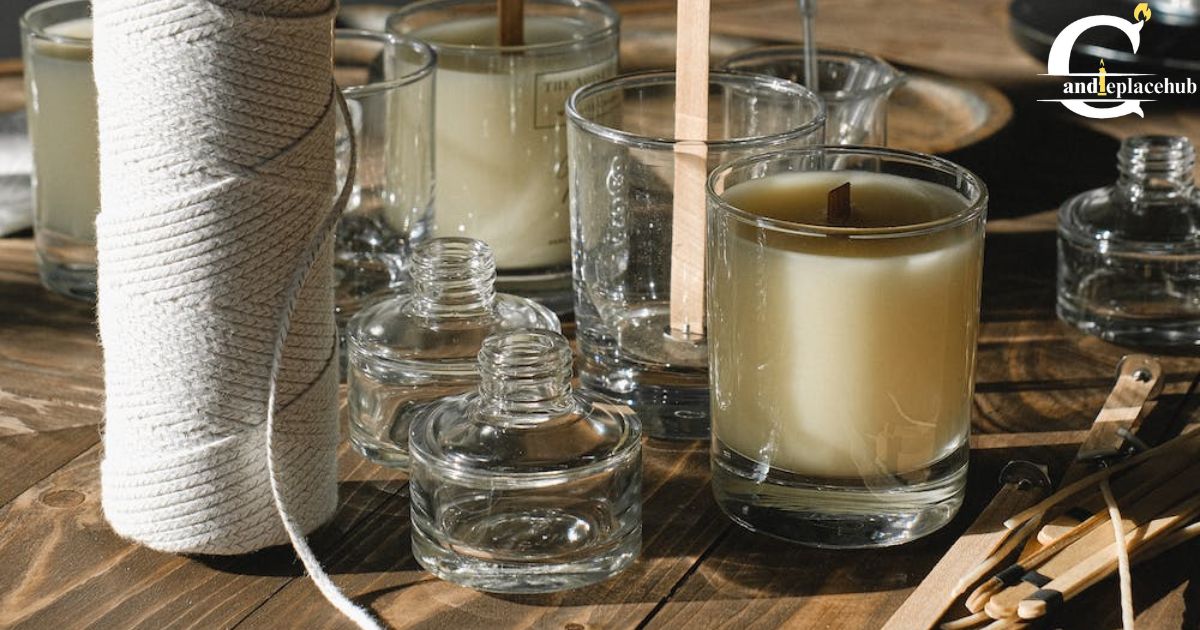Candle wicks are the strings in the middle of a candle that we light. They soak up the wax and then burn making the candle glow. Wicks come in different sizes and choosing the right one helps the candle burn nicely.
Some wicks are made from cotton while others use a blend of cotton or any other stuff. These materials help the wick burn steadily and evenly. When you wonder “What are candle wicks made of?” It is like the secret ingredient that keeps your candle flame shining bright. Let’s explore the secrets that make each flickering flame a story waiting to be told.
The different sizes like big candles need thicker wicks to soak up more wax while small ones use thinner ones. Some burn slow while others go quick like a little burst of light. Next time you light a candle think of the wick as a special superhero string. But wait there is even more cool stuff about wicks that makes candles extra awesome.
The Importance of Candle Wicks
Candle wicks are really important. They are the tiny things in candles that make sure the candle burns the right way. If the wick is good the candle will melt evenly. But if it’s not the wax might not melt properly and the candle won’t burn nicely.
The size and material of the wick decide how fast the candle burns. We need to pick the right wick for the kind of wax we use. If the wick is too big the flame will be too large making the candle drip and produce too much smoke. If it is too small the flame will be weak and the candle won’t use up the wax well. When we light a candle the choice of the wick becomes critical for achieving the desired burning characteristics.
It also affects how the candle feels. A good wick gives a steady and gentle glow. This makes the candle not just a light but also something that makes the room feel nice. The little flame creates a calm and cozy atmosphere.
So, even though they are small candle wicks matter a lot. They make sure the candle burns well, lasts long and adds a lovely touch to any place.
Exploring Different Candle Wick Materials
Different materials are used for making candle wicks each with its unique properties. Let’s explore various candle wicks materials in detail:
Cotton Wicks

Cotton wicks are one of the most common and traditional choices for candle making. They are known for their clean and steady burn. Cotton candle wicks are typically braided and come in various sizes allowing for customization based on the candles size and type.
These wicks are well suited for a wide range of candle formulations including paraffin, soy and beeswax. They produce a consistent flame and minimal soot making them a preferred choice for many candle fans who appreciate a classic and reliable option.
Wood Wicks

Wood wicks are a special kind of wick made from wood like cherry or birch. They are a cool choice for candles because they create a cozy crackling sound when they burn similar to a fireplace.
These candle wicks are often used in soy candles and other types that use wooden wicks. What’s neat about them is that they burn slower and their flame is wider making the candle look cool. People love them for the unique environment they bring to the candle experience.
Alternative Wick Styles
Wickless Candles
Wickless candles also known as flameless or melt candles operate without a traditional wick. They rely on heat sources such as light bulbs or electric heating elements to release fragrance or melt the wax.
Popular in wax melt warmers and candle warmers wickless candles are a safe and flame free option for those seeking to enjoy scents without an open flame. These candle wicks come in various shapes and sizes often shaped as decorative melts or cubes.
Hemp Wicks

Hemp wicks are an eco-friendly alternative to cotton wicks as they are made from natural hemp fibers. Known for their slow burn and minimal soot production. Hemp candle wicks are popular among environmentally conscious consumers.
The natural properties of hemp allow for a consistent and clean flame. Hemp candle wicks are compatible with a variety of waxes including soy and beeswax making them a versatile choice for candle makers who prioritize sustainability.
Paper Core Wicks
Paper core wicks consist of a braided cotton outer layer and a paper inner core. This combination provides additional structural support to the wick preventing it from bending or sagging during burning.
These candle wicks are often used in container candles where stability is critical for an even burn. These candle wicks also contributes to a cleaner burn reducing the risk of carbon buildup and soot production.
Brass Core Wicks
These wicks are designed for their rigidity and stability during burning. The brass core enhances the wicks structural integrity preventing it from flopping over and extinguishing the flame. These candle wicks are commonly employed in larger candles ensuring a consistent burn throughout the entire candles life. The brass core wicks also aids in conducting heat promoting an even and efficient melting of the surrounding wax.
Polyester Core Wicks
These wicks incorporate a polyester fiber within the braided cotton structure. This combination enhances the wicks strength and stability to preventing it from sagging or mushrooming during burning.
Polyester core candle wicks are suitable for a variety of waxes including paraffin and soy. They are often chosen for their durability and reliability in maintaining a steady flame.
Zinc Wicks
Zinc wicks are another metal core option known for their rigidity and resistance to bending. These candle wicks are often used in container candles and are designed to minimize wick trimming.
The zinc core conducts heat efficiently ensuring a consistent burn across the candles surface. Some candle fans may be cautious about using metal core wicks due to potential environmental concerns.
Linen Wicks
Linen wicks are made from flax plant fibers and are considered a natural and sustainable option. These candle wicks offer a clean and steady burn making them suitable for various candle formulations.
These wicks are often used in combination with other natural fibers to create a braided structure that enhances their burning characteristics. Candle makers who prioritize eco-friendly materials may opt for linen wicks as a renewable resource for their candle creations.
How to Choose a Safe Candle Wick?

Choosing a safe candle wick is important to enjoy your candles without worries. Here are some simple tips:
Look for Natural Materials
Choose candle wicks made from natural materials like cotton, wood or hemp. These are safer and often produce less smoke and soot.
Avoid Lead Core Wicks
Stay away from candle wicks with a metal core especially if it’s made of lead. Lead can be harmful when burned so it’s best to choose wicks without metal cores.
Check for Safety Labels
Look for candles with safety labels that indicate they meet certain standards. This shows that the manufacturer cares about safety.
Consider Wick Size
Pick the right wick size for your candle. If the wick is too big, it can create a large flame which might be unsafe. Follow the candle making guidelines or choose candles with appropriate wick sizes.
Opt for High-Quality Brands
Choose candles from reputable and high quality brands. They are more likely to use safe materials and follow strict manufacturing standards.
Avoid Fragrance Additives
Some candles have added fragrances but these can sometimes contain harmful chemicals. If you are concerned about safety consider unscented candles or those scented with natural oils.
Read Reviews
Check reviews from other customers. They often share their experiences and can give you insights into the safety and quality of the candles you are considering.
Trim the Candle Wicks
If you are making candles at home make sure to trim the candle wicks to the recommended length. This helps in preventing the flame from getting too big and ensures a safer burn.
Smelling a Candle: Simple Facts About Fragrances
When you want your home to smell nice with candles it’s essential to know about the scents they use. There are two main types of oils that give candles their smell: essential oils and fragrance oils.
Essential Oils vs. Fragrance Oils
Candle scents can be natural or made in a lab. Essential oils are natural and come from plants giving a pure and real smell. Fragrance oils on the other hand are made in a lab and can imitate natural scents or create new ones. Fragrance oils offer many different smells and are often more affordable.
- Fragrance Load: Fragrance load is like the strength of the smell in a candle. Some candles have a high fragrance load which means they have a strong smell that can fill up a whole room. Others have a low fragrance load giving a milder scent for those who like something more subtle.
- Cold Throw: This is how the candle smells when it’s not burning. It’s what you notice when you sniff the candle without lighting it.
- Hot Throw: This is the scent that comes out when the candle is burning. Some candles might have a different smell when they are lit compared to when they are not.
Candle Holders: More Than Just a Place for Candles
They are not just ordinary containers they are like special homes for your candles. Now here are some cool things about different types of candle holders:
Glass Jars
Glass jars are not just ordinary containers for candles they are like see through homes for your lovely candle creations. These jars let you admire the flickering flame and see how much wax is left. Glass jars come in various shapes and sizes to match your style.
Metal Containers:
Metal containers give candles a cool and modern look. They are sturdy and protect your surfaces from heat. These containers come in different finishes like shiny metal or rustic tin adding a touch of style to your candle.
Ceramic Vessels:
Ceramic vessels are like fancy homes for your candles. They come in beautiful shapes and colors turning your candle into a piece of art. They are not just containers they are part of the candles charm.
Silicone Molds:
Silicone molds are like magic creators for unique candle shapes. You pour the wax into these molds and they give your candle cool forms like stars or hearts. It’s a fun way to make your candles stand out.
Heat Resistance:
Whether it’s glass, metal, ceramic, or silicone these candle homes are heat-resistant champs. They can handle the heat from the burning candle without getting all hot and bothered. You can enjoy your candles safely in these cool containers.
Frequently Asked Questions
What are the most commonly used materials for candle wicks?
Candle wicks are typically made from materials like cotton or a cotton blend. These materials are chosen because they burn well and provide a steady flame for candles.
Can you use a piece of wood as a candle wick?
It’s not a good idea to use wood as a candle wick. Wood doesn’t burn well and may produce a lot of smoke. It is safer to stick with materials like cotton designed for candle wicks.
What else can be used as a candle wick?
Some other materials used for candle wicks include hemp, linen or paper. These also burn steadily and are safe for candles.
Can you use string as a candle wick?
You can use certain types of string as a candle wick. It is crucial to choose a material that burns well and doesn’t produce excessive smoke. Cotton string is a good choice for making a homemade candle wick.
Conclusion
The wick of a candle plays a crucial role in the art of candle making. As we explore the question “What are Candle Wicks Made of?” They are typically made of materials like cotton, hemp or wood each bringing its unique qualities to the final product. The choice of wick material can impact factors such as burn time flame stability and overall candle performance.
Understanding the composition of candle wicks allows candle makers and fans to modify their creations to specific preferences. Whether seeking a slow even burn or a more dynamic flame the choice of wick material provides a customizable element to the candle making process. The simplicity of these small components disproves their significance in shaping the environment and experience that a candle informs.

Hi there! I’m Harrison Ford, a candle fanatic with 8 years of experience. Explore my website to discover the magic of candles through my passion filled journey, where I share tips, stories and everything you need to know about these glowing wonders.











